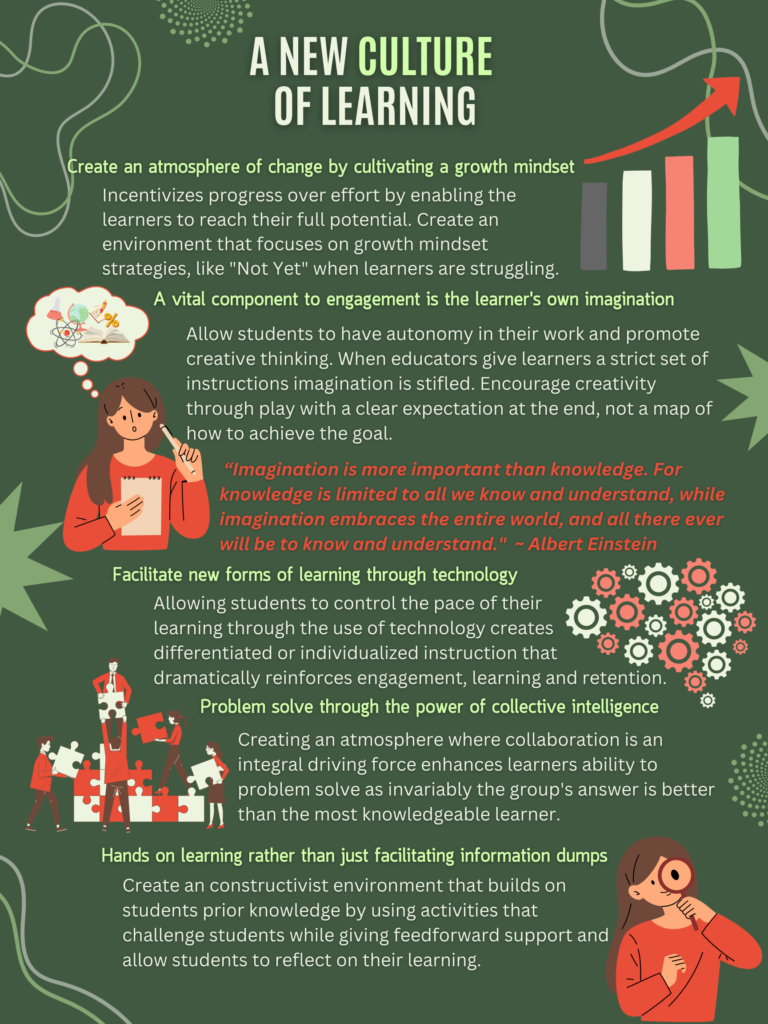
A New Culture of Learning
I found that the information given in The New Culture of Learning was exceptionally light. Compared to the other readings from this master’s course, I struggled with ascertaining how to transfer these limited concepts into any real world application. Dr. Thomas’ only classroom example was over a course that was taught about gaming theory, and how even though he lost control of the class all of the students actually learned (Thomas & Brown, 2011). Lucky for him I suppose. I feel as if this book was an interesting concept and perhaps novel at the time it was written; however, this could have been conveyed in a brief article that spanned perhaps several pages. Dr. Thomas describes this new learning environment as a place where learners are engaged with imagination through passion with only limited constraint (Thomas & Brown, 2011). Dr. Thomas describes many different concepts but fails to tie this learning to real life scenarios or examples that could prove useful.

Notably, Dr. Thomas’s attempt at using World of Warcraft leads me to believe that he does not truly understand the concepts that he is alluding to in his book. This may be due to the fact that he only casually interacted with the game. Dr. Thomas talks about tacit learning and speaks of so-called “theory crafting” and “raids” in the same manner he talks about educating people. These are terms of art specific to these kinds of games. Theory crafting is the process by which players experiment and eventually determine the explicit formulas that govern the game’s rules. Raids are unique challenges that require a large number of players, between ten and forty, to coordinate their efforts to overcome larger-than-life enemies. Given Dr. Thomas’s treatment of gaming, Dr. Thomas demonstrates a casual interaction with both the world of education and gaming. I am confident in my judgment because I happen to be fully embedded in both worlds.
The video clip below is a single raid encounter from my former guild in World of Warcraft (WoW). I played a hunter named Trigger and this particular fight highlights just how much of a choreographed dance the raids could be. To anyone unfamiliar with WoW, the video is going to look chaotic, busy, and nigh incomprehensible. Each of the characters you see moving about is a player, with the exception being the very large character named Operator Thogar. The singular goal of this encounter is to survive the onslaught of attacks and bring Operator Thogar down, as indicated by the health bar over his head. All of the data, numbers, commands, instructions, and other information streaming across the screen is information a single player utilizes to analyze their performance in real-time throughout the encounter while performing the necessary sequence of movements and key presses to invariably overcome the challenge. Of note is that this encounter was not unique in its complexity or strict adherence to rigid performance objectives, but rather considered merely above average compared to dozens of other challenges.
In the realm of WoW, there are generally three types of people. One type are serious gamers that know what the game is about and how to play the game. They pour over the code, create the math, make strategies, and even write programs to help players play the game. This is the point of theory crafting: breaking the game down so that play and success can be optimized. The second is the raider: they read what the theory crafters write, they memorize the entire fight, they know what skills to use and in what order, they know where to stand and when to move. The entire game may seem like chaos to the average person, but the successful raider knows what every detail means because they took the time to learn it all. The last person is the casual player. Casual players do not read, have no real clue as to how to play the game successfully, and just use whatever skills and abilities seem cool while hoping for the best. In the end, based on trial and error, these casual people sometimes finally defeat the monsters. Instead of being successful in the game from the beginning, these casual players run around spending days trying to accomplish something a raider finished in just a few hours. Not only that, these casual players always failed many challenges before the end of the game and eventually quit. For the casual players that stay, the game moves past them by opening a new expansion with new monster areas. However, new content often gives those casual players a handicap to finally defeat the old monsters in a much easier mode. The only way for these casual players to reach the end of the game without a cheat is to read how to play and practice, or find a raider that is willing to be their mentor.

Dr. Thomas’s experiences definitely qualify him as a casual player, never really moving past simply experiencing events in a game that demands increasing levels of perfect performance to succeed. Using the model of a casual game player should not be how anyone should want to educate people. Sure, trial and error is a fantastic way to learn, but educators need to go into the lesson with a plan. Tacit learning in WoW is highly limited to a few basic concepts. Monsters with the name “priest” or “medic” will most likely heal the other monsters, so take that one out first. Finding herbs to pick is easier when the player learns some plants prefer water or shaded areas. Dragons and other large beasts are especially dangerous since most breath fire and use their tails offensively, giving players limited safe places to be. However, most challenges in WoW, notably raids, require so much more than merely appreciating these superficial concepts. Objective pass/fail thresholds exist that players must overcome, measured in numerical outputs such as those you see in the video, or those found on third-party websites that track performance and post it publicly.

Overall, Dr. Thomas’s attempt at using WoW makes me think that he is truly unaware of the concepts that he is alluding to in his book. This may be due to the fact that he only casually interacted with the game. He talks about tacit learning and speaks of theory crafting and raids in the same manner he talks about educating people. He casually interacts in the world of education. The majority of professors are in their positions not to teach but to research and promote the university, they lecture with Powerpoint presentations and often couldn’t care less if their students pass or fail. If a person is an educator they need a plan to be successful. That plan may be to allow learners to have free reign and create anything they see fit, as Dr. Thomas describes, but that is a difficult design to make successful. Worse, such an environment can produce wildly undesirable outcomes, frustration, and ultimately lead to giving up, just like casual players frustrated they cannot overcome the next challenge. Rules are put in place to ensure that the learners ultimately end up in a preferred final destination with the desired learning outcomes achieved. This means that proper implementation of the rules are set in place by the facilitator not to limit creativity but to guide creativity on a path to success.
Implementing a New Culture of Learning:
In the end, I did piece together some great concepts regarding what Dr. Thomas was saying, based on what I have learned in the master’s program at Lamar University. Using Dr. Thomas’s overarching concepts coupled with the books we have already read from authors like Carol Dewit, Joseph Grenny and Dr. Harapnuik, I created an infographic that outlines why we need a new culture of learning.
Instructors should create an atmosphere of change by cultivating a growth mindset that incentivizes progress over effort by enabling the learners to reach their full potential. These environments should focus on growth mindset strategies, like “Not Yet” when learners are struggling. These environments should avoid the false growth mindset by avoiding praising effort learners for mere effort but rather for progress (Dweck, 2016). These should be intentional acts of praise coupled with the educator’s guidance for learners that fall short of accomplishing the goal. Going back to the WoW scenario: a mentor for the casual player coaches them on how to perform and the damage numbers the players amass shows whether or not they were successful. When they fall short of expected damage, the mentor may inform them they need to perfect their “rotation”, or the ordered series of commands and steps needed to maximize performance. In another example, in a math classroom the students either succeed and get the correct answer or fall short. Teachers should redirect the students by highlighting their mistakes and encouraging or guiding them to correct those mistakes within the steps of the problem. In educating adults, instructors see learners failing to grasp the concept or put the skills into proper use. These instructors are once again there to coach and guide the learner to success through direct intervention or guidance.
“Imagination is more important than knowledge. For knowledge is limited to all we know and understand, while imagination embraces the entire world, and all there ever will be to know and understand.” ~ Albert Einstein
A vital component to engagement is the learner’s own imagination. Allow students to have autonomy in their work and promote creative thinking. When educators give learners an overly strict set of instructions, imagination is stifled. Encourage creativity through play with a clear expectation at the end, not a map of how to achieve the goal. In my innovation plan, learners create a project at the end of a set of learning units. The purpose of the project is for the students to create something that illustrates their learning, not for the instructor to obtain 150 identical projects. The end goal in this scenario is for the students to illustrate a scientific concept in an innovative way. This will be difficult for the learners as they have never been confronted with such an open project. In professional development this same concept could be used to help motivate adult learners. Simply give them a goal to achieve and let the learners’ own creativity be their driving force to find a way to accomplish the request.
Educators should facilitate new forms of learning through technology by allowing learners to control the pace of their learning through the use of technology. This creates differentiated or individualized instruction that dramatically reinforces engagement, learning and retention. In my innovation plan, learners will work on self paced assignments through the use of technology. Unlike online learning, the students will have a sharing session where each student discusses the concepts they learned for the day with the teacher. This use of blended learning allows for individualized instruction that is geared toward their method of learning.

Instructors should encourage problem solving through the power of collective intelligence by creating an atmosphere where collaboration, as an integral driving force, enhances learners’ ability to problem solve. Invariably the group’s answer is frequently better than the most knowledgeable individual learner. Most people hate group projects because there is one person in the group that does not pull their fair share. Accountability must be put into place. This can be accomplished when educators/managers request a debrief of their progress. Each team member is required to convey what they have accomplished and where they are headed. This accountability vastly improves teamwork since it allows for no individual to sit on the sidelines and watch as others perform. When all members become active, conversation about what needs to be done can flourish. This requires time built into the program to speak to each team, and for educators/managers to understand the value of creating a cadence of accountability (McChesney et al., 2022).

Hands-on learning, rather than just facilitating information dumps, creates a constructivist environment that builds on students’ prior knowledge by using activities that challenge students while giving feedforward support and allows students to reflect on their learning. Going back one last time to the WoW scenario: even the most advanced raider who reads the fights and knows what must be done to defeat the monster, realizes that this information will not compare to the first hand knowledge of seeing the monster in action. All too often my guild would start a new fight with the phrase, “Let’s pull him, so we can all see what this monster does.” We all knew what the fight would entail on paper, but it is different when you see the trains coming in all directions as you desperately try to dodge, as shown in the video. Nothing beats hands-on experience. This is why doctors acquire literary knowledge of their art first and then practice on cadavers, before ever touching their first live patient. When instructors stand at the front of a room spouting off their information and learners desperately try to take notes or stay awake, their knowledge is only the superficial level. Research shows that active learning promotes high-ordered thinking cognitive skills (Sugeng et al., 2020). These people solving skills are vital to the success of the learner inside and outside of the learning environment. This is a call to action for all educators that instruct adults or children to stop waiting for someone else to change the current method of how learners are educated. It is time to collaborate and create a constructivist environment where learners have the opportunity to interact and truly learn.
References:
Dweck, C. (2016, January 11). Recognizing and overcoming false growth mindset. Edutopia. Retrieved January 29, 2023, from https://www.edutopia.org/blog/recognizing-overcoming-false-growth-mindset-carol-dweck
Graef, A. (2018, March 19). Cartoon: Good vs. bad teachers. The Ranger. Retrieved January 29, 2023, from https://theranger.org/2018/03/19/cartoon-good-vs-bad-teachers/
Kelly, J. (2017, April 25). You are better than a selfie. you are worth a professional photographer. KeliComm. Retrieved January 29, 2023, from https://kelicommheadshots.com/you-are-better-than-a-selfie/
McChesney, C., Covey, S., Huling, J., Walker, B., & Thele, S. (2022). The 4 disciplines of execution: Achieving your wildly important goals. Simon & Schuster Paperbacks, an imprint of Simon & Schuster, Inc.
Readingraphics. (2022, October 20). Book summary – the 4 disciplines of execution: Achieving your wildly important goals. Readingraphics. Retrieved January 29, 2023, from https://readingraphics.com/book-summary-the-4-disciplines-of-execution/
Thomas, D., & Brown, J. S. (2011). A new culture of learning: Cultivating the imagination for a world of Constant Change. CreateSpace?
Sugeng, B., & Suryani, A. W. (2020). Enhancing the learning performance of passive learners in a financial management class using problem-based learning. Journal of University Teaching and Learning Practice, 17(1), 60–79. https://doi.org/10.53761/1.17.1.5
Vincent, E. (2021, March 13). 6 hands-on history activities for homeschoolers. iHomeschool Network. Retrieved January 29, 2023, from https://ihomeschoolnetwork.com/hands-on-history-activities/






